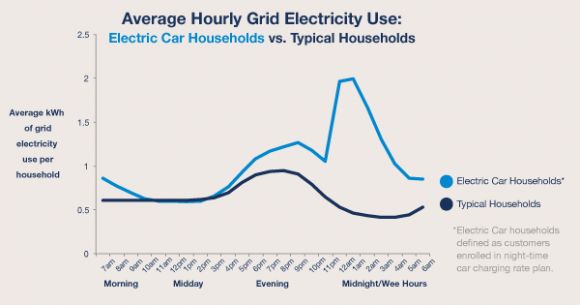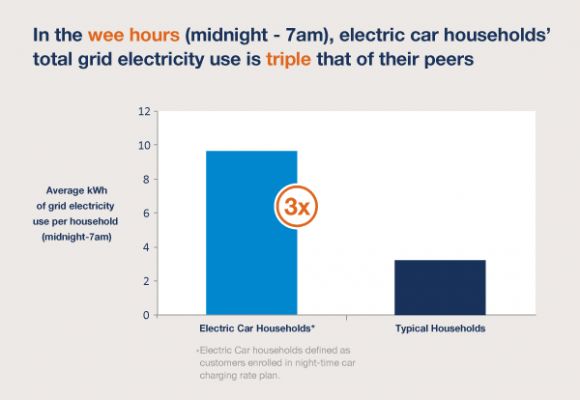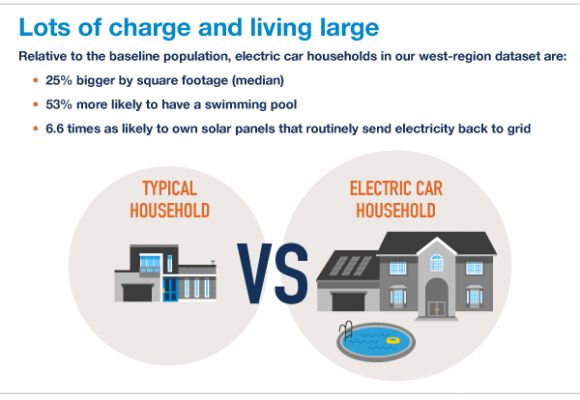By day, electric vehicles are taking the world by storm: their sales are doubling every year, their fuel efficiency is off the charts, and some of them can even accelerate from 0-60 mph about as fast as you can say "Elon Musk."
By night, the electric vehicle (EV) community continues to make waves. While you are in bed dreaming about how you too might own an electric car someday, many EV owners are doing something that is reshaping the energy landscape.
They are using gobs of electricity.
Today we once again crack open Opower’s energy data storehouse -- the world’s largest, spanning more than 50 million households worldwide -- to examine the energy usage behavior of an increasingly important segment of utility customers: electric car owners who charge their car in the wee hours of the night.
To fuel our analysis, we evaluated anonymous data from about 2,000 night-charging EV owners in the western U.S. (more details on the methodology are available here) -- a region where Teslas, Nissan Leafs and other plug-in electric cars abound.
Our statistical findings suggest how vastly EV owners’ energy profiles can deviate from normal; why the timing of EV charging is so important; how solar panels fit into the picture; and what it all means for utilities, their customers, and the future of the electric grid.
After a long day, it’s time for a good night’s charge
The wee hours have in recent years gained traction as a popular time for EV owners to recharge their vehicles.
In the hourly usage curves below, you can see that the EV owners in our dataset (light blue) exhibit a massive spike in electricity use beginning at midnight, shooting up to around four times the average level.

Graphic credit: Waleed Al-Alami
Why the huge usage bump at midnight sharp? The answer hinges on incentives and utilities’ ability to shape consumer behavior.
Specifically, many EV owners in the western region of the U.S. (upwards of 60 percent, according to one California study) and all the EV owners considered in our analysis have signed up with their utility to get highly discounted electricity in the hours between midnight and 7 a.m., in exchange for a daytime price hike. The sudden surge shown on the right side of the graph above suggests the behavioral effectiveness of this framework: when EV owners enroll in a time-of-use rate plan, they tend to operate in alignment with it.

Graphic credit: Waleed Al-Alami
Offering an off-peak rate plan is often a savvy move on the part of utilities: it helps them prevent power-hungry electric cars from overtaxing the electric grid during the day, when system-wide demand is already on the high side. As we’ve examined in a previous blog post, high electric demand in the afternoon hours is notorious for destabilizing the power grid.
That’s why utilities in numerous states ranging from California to Texas to Georgia have been quick to introduce targeted customer engagement programs and off-peak charging incentives that help smooth the integration of EVs into their territory. Last month, Minnesota became the first state to roll out a statewide approach for promoting night-time EV charging.
We’ve seen above that EV owners who have an incentive to charge their car at night understandably exhibit abnormal electricity usage during those hours. What may be more surprising is what happens after the sun rises.
After the sun rises, electric car owners are still different
It’s morning, around 7 a.m. Teslas have been charged, the time-of-use electricity price for participating EV households has cranked up, and the hourly electric usage from those households has diminished.
However, despite the marked reduction in usage, EV rate plan subscribers continue to out-consume their peers even during the waking hours. Between 7 a.m. and midnight, they use an average of 21 percent more electricity from the grid than the typical single-family household.

Graphic credit: Waleed Al-Alami
EV owners’ outsized grid electricity consumption during the waking hours appears to register at specific times of day, particularly in the morning and evening. For a visual perspective, look at the hourly usage curves shown above, which illustrate that EV rate subscribers’ grid electric usage during the edges of the day (i.e., 7 a.m.-9 a.m. and 5 p.m.-midnight) are relatively high, but usage during midday is actually below normal.
Why? Consider a couple of key factors that may help explain EV owners’ distinctive usage pattern during the waking hours.
1) EV owners appear to have larger electricity needs, especially when at home
People are more likely to be home in the morning and evening; EV owners may be especially likely to use more power at those times because they have bigger homes as well as more amenities (see below); it’s also entirely plausible that some EV owners may occasionally charge their EV during those times, even though their time-of-use rate plan discourages this kind of behavior.

Graphic credit: Waleed Al-Alami
2) EV owners are much more likely than their peers to own solar panels
One recent survey among utility customers in the western U.S. found that 32 percent of EV owners had installed rooftop solar, which drastically reduces their grid electric consumption during the sunny middle period of the day. Likewise, we discovered that many EV households’ afternoon solar generation routinely exceeds their own needs. Our regional analysis shows that one in thirteen EV rate-plan subscribers regularly spin their electric meter backwards via solar, compared to just one in 86 typical households.
Thanks to their surplus solar generation, EV owners who are also solar super-users actually consume a tad less total daily grid electricity than the typical utility customer.

Graphic credit: Waleed Al-Alami
In light of EV rate-plan subscribers’ unique behavioral and household profile, it’s striking that having a sufficiently large solar rooftop can make them look pretty darn normal when considering total daily grid electric usage.
More after-midnight action is on the way
With their huge night-time charging spike, bigger and fancier homes, and elevated grid electric consumption in the morning and evening, EV rate-plan subscribers are a distinctive type of energy user.
And it appears that there are many more of them on the way. Last month, eight U.S. states announced a market development plan to put 3.3 million zero-emission vehicles on their roads by 2025. This month, Tesla CEO Elon Musk released his company’s patents to catalyze the growth of the broader EV industry. Meanwhile, states and utilities are taking bold steps to support off-peak charging options that play nicely with the power grid and make EV fueling more affordable.
Utilities will play a central role in shaping how the EV landscape unfolds in the coming decades. As an increasing number of EV owners begin to plug in, utilities are well positioned to advise them and guide their behavior (e.g., encouraging them toward night-time charging) in a way that helps smoothly integrate electric vehicles into the modern electric grid -- in parallel with other critical trends like distributed solar generation, changes in energy prices, and new controls on power plant emissions.
***
Barry Fischer is the head writer at Opower, where he manages the Opower Outlier blog. Ben Harack is an implementation engineer at Opower.
This piece is reprinted with permission from the Outlier data blog at Opower, which provides a cloud-based customer engagement platform to the global utility industry. Opower processes data from more than 52 million households -- analyzing more than 100 billion meter reads per year and combining it with data on weather, demographics, and behavior -- to help utilities become personalized energy advisors for their customers.



